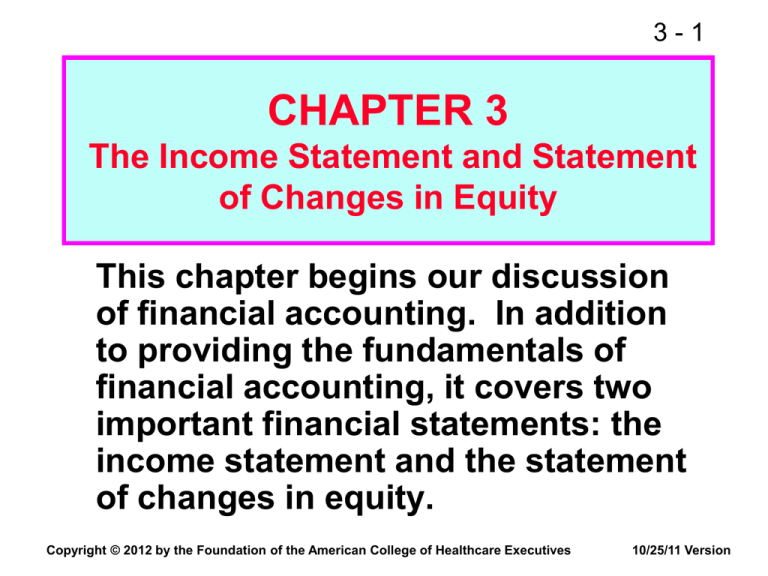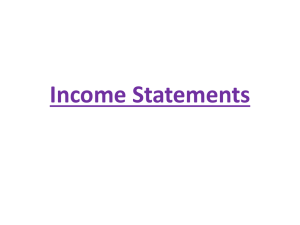CHAPTER 3
advertisement

3-1 CHAPTER 3 The Income Statement and Statement of Changes in Equity This chapter begins our discussion of financial accounting. In addition to providing the fundamentals of financial accounting, it covers two important financial statements: the income statement and the statement of changes in equity. Copyright © 2012 by the Foundation of the American College of Healthcare Executives 10/25/11 Version 3-2 Introduction to Financial Accounting Financial accounting involves identifying, recording, and communicating the operational results and status of an organization (as opposed to a subunit). Financial accounting information is conveyed by a business’s financial statements: Income statement Statement of changes in equity Balance sheet Statement of cash flows 3-3 Introduction to Financial Acct. (Cont.) The requirement to provide financial accounting information is driven by the need of outsiders to have reliable information regarding the financial status of an organization. However, the information presented in financial statements is as important to managers as it is to investors. Who are the outsiders? Do not-for-profit organizations have to prepare financial statements? Should the preparation and presentation of financial accounting data be regulated? 3-4 Regulation and Standards The Securities and Exchange Commission (SEC) has the legal authority to regulate the form and content of financial statements. However, the SEC relies on the following organizations for implementation: Financial Accounting Standards Board (FASB) Industry Committees of the American Institute of Certified Public Accountants (AICPA) Principles and Practices Board of the Healthcare Financial Management Association (HFMA) 3-5 GAAP The conventions that have evolved from the pronouncements and rulings of the implementing organizations constitute a set of guidelines for the preparation of financial accounting statements called generally accepted accounting principles (GAAP). The GAAP applies only to financial accounting statements (as opposed to statements constructed for internal use). Does the GAAP remain static over time? 3-6 Conceptual Framework for the Recording of Economic Events The goal of financial accounting is to provide information that is useful to present and future investors and other users in making rational financial and investment decisions. To achieve this goal, GAAP specifies four assumptions, four principles, and four constraints. 3-7 Conceptual Framework (Cont.) Assumptions Accounting entity Going concern Accounting period Monetary unit Principles Historical costs Revenue recognition Cost matching Full disclosure 3-8 Conceptual Framework (Cont.) Constraints Objectivity Materiality Consistency Conservatism 3-9 Cash Versus Accrual Accounting Cash accounting recognizes an event when a cash transaction takes place. Simple and easy Mimics tax statements Accrual accounting recognizes an event when a cash obligation is created. More complicated Provides a better picture of the true economic status of a business Is required by GAAP 3 - 10 Recording and Compiling Data A transaction is an exchange of goods (including cash) or services from one individual or business to another. Once a transaction is identified, it must be recorded, or posted, to an account, which identifies a unique activity within the business. Businesses use a chart of accounts to assign numeric identifiers to individual accounts. 3 - 11 Recording and Compiling Data (Cont.) Each transaction is posted by a journal entry. Because journal entries are always posted twice, the system is called a double entry system. To handle the double entries, accounts are set up in a T format, and hence they are known as T accounts. 3 - 12 Recording and Compiling Data (Cont.) Ultimately, the journal data are used to create financial statements: Income statement Statement of changes in equity Balance sheet Statement of cash flows The primary means for disseminating financial statements is the annual report. It begins with a verbal discussion of current operating results and expectations for the future. Followed by the financial statements, which include footnotes. 3 - 13 Income Statement Basics Perhaps the most important question about a business’s financial status is whether or not it is making money. The income statement provides information about a business’s operations and economic profitability. The income statement is often called by other names: Statement of operations Statement of activities Statement of revenues and expenses 3 - 14 Income Statement Basics (Cont.) The income statement reports the results of operations over some period of time, say, a year. It has three key elements: Revenues, which under accrual accounting represent both cash received and payer obligations. Expenses, which are the resource expenditures required to produce the revenues. Again, note that under accrual accounting both cash and noncash expenses are recognized. Profit measure = Revenues - Expenses. 3 - 15 Sunnyvale Clinic: Revenues (in thousands) Revenues: Net patient service revenue Premium revenue Other revenue Total revenues 2011 2010 $150,118 18,782 3,079 $171,979 $123,565 16,455 2,704 $142,724 3 - 16 Revenues Revenues are shown in several different formats depending on the type of provider. Sunnyvale has three revenue categories. Net patient service revenue reflects the amount of revenues expected to be collected from the provision of patient services (as opposed to gross revenue, which is based on chargemaster prices). Premium revenue represents revenue from capitated patients. Other revenue is revenue from activities directly related to patient services, such as parking fees and cafeteria revenues. 3 - 17 Revenues (Cont.) In reporting net patient service revenues, note how the following categories are handled: Discounts and allowances from gross prices are not reported as revenue. Charity care is not reported as revenue. Under current GAAP, bad debt losses are not reported as revenue, but are reported in the expense section. Beginning in 2012, expected bad debt losses will be reported as a deduction in the revenue section. 3 - 18 Revenues (Cont.) Note that the revenue reported does not represent the amount of cash collected: Some portion has not yet been collected. The uncollected portion will appear on the balance sheet in an account titled receivables. In addition, some revenues reported in the previous year were collected this year. What impact does capitation have on the amount of receivables? 3 - 19 Sunnyvale Clinic: Expenses (in thousands) Expenses: Salaries and benefits Supplies Insurance Lease Depreciation Provision for bad debts Interest Total expenses 2011 2010 $126,223 20,568 4,518 3,189 6,405 2,000 5,329 $168,232 $102,334 18,673 3,710 2,603 5,798 1,800 3,476 $138,394 3 - 20 Expenses Expenses represent the resources used to create revenues--they are the costs of doing business. Like revenues, under accrual accounting expenses do not necessarily reflect cash outlays. Expenses may be categorizes by: Natural classification, such as salaries, supplies, research, and so on. Functional classification, such as inpatient services, outpatient services, and so on. Which classification system is better? Which system does Sunnyvale use? 3 - 21 Expenses (Cont.) Salaries and benefits expense represents labor costs. Typically, this is the largest expense category for health services organizations. Although only summary information is given on the income statement, details are available internally from the managerial accounting system. Supplies expense represents the cost of expendable (primarily medical) materials. The dollar amount shown represents the amount consumed, not the amount purchased. Supply stocks are reported on the balance sheet. 3 - 22 Expenses (Cont.) Insurance expense represents the cost of commercial insurance purchased to protect the clinic against several risks, including: Property risks • Fire • Weather Liability risks • Managerial malfeasance • Medical liability 3 - 23 Expenses (Cont.) Sunnyvale owns most of its land and buildings, but it leases much of its diagnostic equipment. Lease expense reports the cost of its leases. On the balance sheet, some leased assets are reported directly (on the face) while others appear only in the footnotes. Regardless of balance sheet treatment, all lease expense is reported on the income statement. Why do organizations use leases? 3 - 24 Expenses (Cont.) Depreciation expense arises because of the matching principle--expenses must be matched to the revenues with which they are associated. While operating costs such as labor and supplies are assumed to produce immediate revenues and hence are moreor-less immediately reported (expensed) on the income statement, the costs of longlived assets (buildings and equipment) are not reported on the income statement at the time the acquisition is made. 3 - 25 Expenses (Cont.) Rather, the “cost” of a long-lived asset is first capitalized (recorded on the balance sheet as an asset of the business). Then, this amount is amortized (or spread) over the accounting life of the asset, which means the cost is shown (expensed) on the income statement as small increments over time. The amortization expense of buildings and equipment when listed on the income statement is called depreciation. For financial accounting purposes, depreciation is calculated by the straight-line method. 3 - 26 Expenses (Cont.) Most expense items listed on the income statement only approximate actual cash expenditures. The relationship is not exact because of accrual accounting. However, depreciation (and amortization) are expenses that typically have no associated cash expenditure during the accounting period. Such an expense is referred to as a noncash expense. 3 - 27 Expenses (Cont.) Provision for bad debts reports the amount of net patient service revenue that is not expected to be collected. It is an estimate based on past experience. Past estimates are reconciled when the data are known. This item will be moved into the revenue section in 2012. Interest expense reports the amount of interest paid (or obligated) on debt financing. 3 - 28 Sunnyvale Clinic: Operating Income (in thousands) 2011 2010 Revenues: Total revenues $171,979 $142,724 Expenses: Total expenses $168,232 $138,394 Operating income $ $ 3,747 4,330 3 - 29 Operating Income Although the reporting of revenue and expenses is important, profitability is the most important element of the income statement . Operating income measures economic profitability as defined by GAAP with a focus on patient service activities. It is an important measure of profitability because it represents the organization’s core business. 3 - 30 Sunnyvale Clinic: Nonoperating Income (in thousands) 2011 Nonoperating income: Contributions Investment income Total nonop. income $ $ 243 3,870 4,113 2010 $ $ 198 3,678 3,876 3 - 31 Nonoperating Income Nonoperating income reports income (revenues) from activities not related to the provision of patient services. Contributions report donations to Sunnyvale Clinic that can be immediately spent. (Contributions that create endowments are not reported on the income statement.) Investment income lists income from (1) excess cash held as reserves or to meet known future needs and (2) endowments. 3 - 32 Sunnyvale Clinic: Net Income (in thousands) 2011 2010 Operating income $ 3,747 $ 4,330 Total nonop. income $ 4,113 $ 3,876 Net income $ 7,860 $ 8,206 3 - 33 Net Income The second measure of profitability, which is often referred to as the “bottom line,” is net income. Net income measures the overall (total) economic profitability as defined by GAAP. In not-for-profit businesses, net income typically is called: Revenues over expenses Excess of revenues over expenses Change in net assets 3 - 34 Net Income (Cont.) The income statements of some not-for-profit corporations contain a section below the net income line that reconciles net income with the balance sheet net assets (equity) account. (Sunnyvale uses a separate statement, discussed shortly.) Note that economic profitability is a complex concept that is very difficult to measure, because economic gains and losses often are not matched by easily identifiable and measurable events. What does this complexity mean for users of financial statement information? 3 - 35 Net Income Versus Cash Flow Because of accrual accounting, net income does not represent cash flow. Some income statement items represent cash flows, others do not. Some, such as revenues, represent partial cash flows. With only income statement data, cash flow (CF) can be approximated by: CF = Net income + Noncash expenses = Net income + Depreciation = $7,860,000 + $6,405,000 = $14,265,000. 3 - 36 Income Statements of Investor-Owned Businesses The income statements of investorowned and not-for-profit businesses are very similar. The revenues and costs to organizations in the same line of business are similar, regardless of ownership. However, some transactions, such as income tax payments, clearly are applicable only to forprofit businesses. Line of business differences have a greater impact on financial statements than do ownership differences. 3 - 37 Sunnyvale Clinic: Statement of Changes in Equity (in thousands) 2011 7,860 2010 Net income $ $ 8,206 Equity, beginning of year $ 46,208 $ 38,002 Equity, end of year $ 54,068 $ 46,208 3 - 38 Statement of Changes in Equity The statement of changes in equity reconciles the income statement net income item with the balance sheet equity account. For a not-for-profit organization, the entire amount of net income flows to the balance sheet. In a not-for-profit business, there are typically deductions to net income (often dividends) that reduce the amount that flows to the balance sheet. 3 - 39 An Introduction to Financial Condition Analysis In financial condition analysis, values from the financial statements are combined to form ratios that have easily interpretable economic meaning. For example, total (profit) margin: Net income Total margin = Total revenue $7,860 = = 0.045 = 4.5%. $176,092 How is this ratio interpreted? 3 - 40 Conclusion This concludes our discussion of Chapter 3 (The Income Statement and Statement of Changes in Equity). Although not all concepts were discussed in class, you are responsible for all of the material in the text. Do you have any questions?







